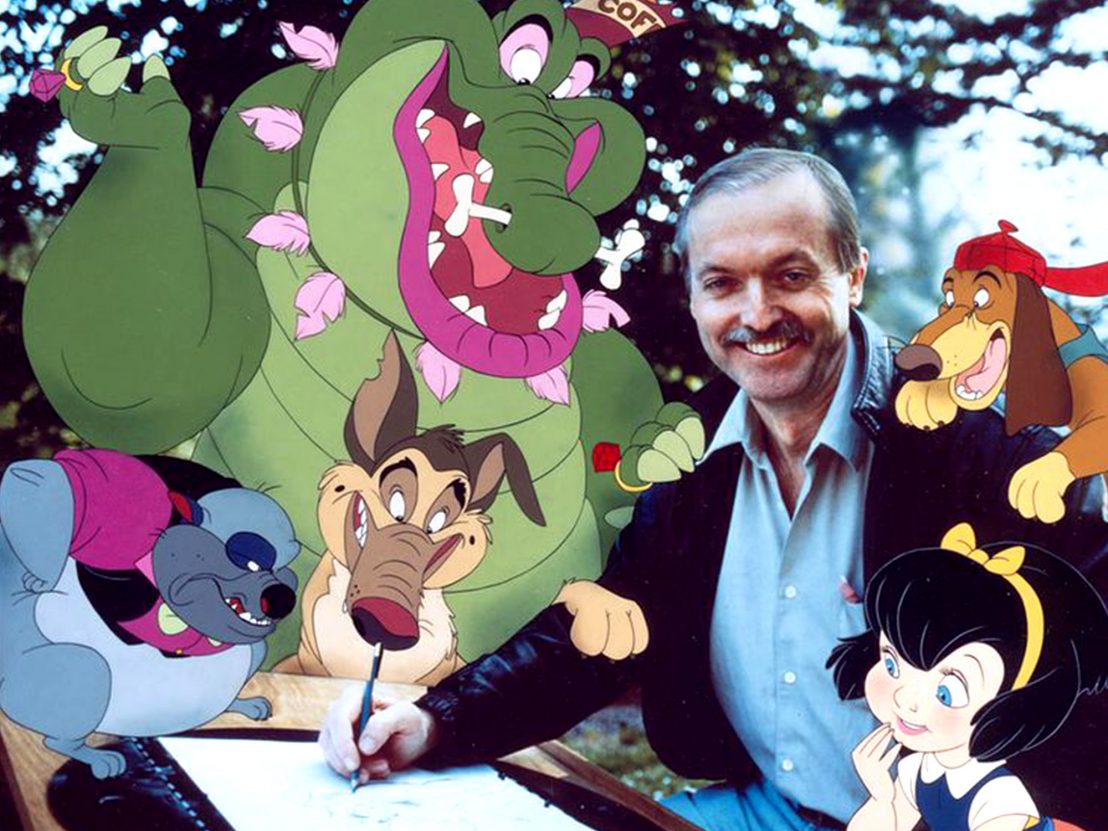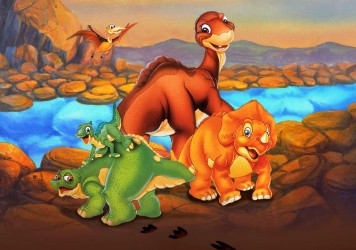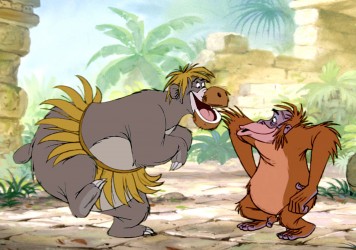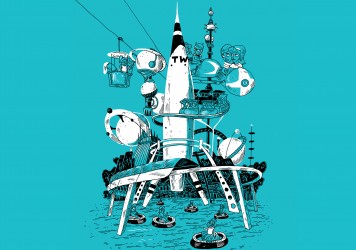
There was a brief moment in the mid to late ’80s when a relatively small company, backed by a studio in Dublin, successfully competed against Disney with the likes of An American Tail, The Land Before Time (which celebrates its 30th anniversary this year) and All Dogs Go to Heaven. But the monstrous success of The Little Mermaid at the tail end of 1989 swung things in Disney’s favour. The animation giant’s biggest commercial hit since 1967’s The Jungle Book marked the beginning of Disney’s so-called renaissance – and ultimately the end of Sullivan Bluth Studios. But let’s get to all that in a moment.
Don Bluth is a Texan and a Jack of all trades. He trained as an animator but also worked as a director, producer and designer. From 1959 to 1977 he worked for Disney on a number of projects (Sleeping Beauty, The Sword in the Stone, Robin Hood, The Rescuers), and in 1979 struck out with a small group of animators to set up his own rival studio with the aim of keeping traditional cel animation alive – a style that Disney was gradually moving away from.
But after releasing just one feature-length production, The Secret of NIMH, Don Bluth Productions filed for bankruptcy. After struggling to get various new projects off the ground, Bluth filed for bankruptcy for a second time in 1985. The business side of things, it appeared, was not his strong suit. Enter Morris Sullivan, a prominent businessman who had founded his own financial consulting company, Sullivan was impressed with the combined talent of Bluth and his two closest allies, fellow Disney defectors Gary Goldman and John Pomeroy. He agreed to form Sullivan Bluth Studios with an initial cash injection of $5 million, and the company was reborn.
Arriving in Dublin with an initial staff of 85 to cut costs between Ireland and California, the move was made permanent in November 1986 after the Irish government offered Sullivan Bluth Studios the largest grant in the country’s history to relocate permanently in return for five per cent ownership of the studio. Together with Sullivan’s investment, it was enough to open up an extremely modern six-storey, 42,000 square foot studio next to Phoenix Park. The Studio boasted 21 departments and employed over 350 people in jobs ranging from animation to administration (75 percent of which were Irish). Another $4.5 million was spent on equipment and furnishings to create what came to be known as one of the most sophisticated classical animation studios in the world.
There was a lab for developing black-and-white footage, theatres and plenty of audio and editing facilities. The editorial space itself was made up of viewing rooms replete with large screens and Moviola equipment sent over from Burbank. There were air-conditioned projection rooms, one of which had a single 35mm projector system for dailies and another with a 32-seat screening room and two universal projectors for smooth turnover between reels.
The sound department boasted cutting-edge equipment, including Tascam multitrack recording systems, Magna-Tech sound transfer and modification equipment, a room specifically for recording narration and sound effects, as well as a huge in-house sound effects library. To top it off, Bluth then set up The Irish School of Classical Animation in Ballyfermot College to solidify links with his new homeland. If all things went well, there was even talk of a Sullivan Bluth theme park revolving around all their onscreen characters. With every possible angle covered, success seemed almost guaranteed.
Yet not everyone shared Bluth’s vision of creating darker, decidedly more mature animated features. Children and adults alike wanted colour, adventure, endless joy. But Bluth liked to push things this way and that, often to his detriment. Released in November of 1986, An American Tail, a film full of heart and whimsy, made a strong return on its $9 million budget despite receiving mixed reviews. Two years later, The Land Before Time proved a somewhat unexpected smash hit, grossing a massive $84 million. Reviews were generally positive and the film was seen as a vast improvement on the studio’s previous release. It had a general appeal that brought in audiences young and old. So, had Bluth finally found the recipe for success?
Not exactly. In 1989, All Dogs Go to Heaven saw a total reversal of fortune for Sullivan Bluth Studios – indeed, it all but ended the partnership. Critics found the story confusing and the characters difficult to like. It was released on the same day as The Little Mermaid, who had gone all out with a far superior budget and soundtrack. Despite All Dogs Go to Heaven making a small profit, the company’s financial backers promptly withdrew, resulting in all future projects being scrapped. Suddenly the future of the studio looked bleak. The renamed Don Bluth Entertainment pushed ahead with Rock-a-Doodle, going up against FernGully: The Last Rainforest, which impressively blended computer and hand-drawn animation. It was a commercial disaster, and the death knell for Bluth’s career.
Between 1992 and 1995 Bluth put out a string of sloppily produced, poorly received films after a lot of financial wrangling. Some animators were working for free with Bluth covering the company’s overheads out of his own pocket. Due to the nature of hand-drawn cel animation, Bluth productions were always incredibly labour-intensive and expensive to make. From an editorial stand, it took many rounds and stages to perfect the final vision; from the sketch stage, the full development of all the characters could take up to six months. The story would be processed by the layout and background departments, then passed on to a further planning department, before the full set of some one and a half million individual drawings were painstakingly painted out from paper and exposure sheet to cel.
To give some context as to the cost of producing a soundtrack for one Bluth feature, anywhere between 50 to 100 musicians were used to record the final score. This could take as long as five days comprising two three-hour sessions at a cost of $10-20,000 per day. This was a hell of a lot of money back in the late ’80s and early ’90s. Bluth refused to cut corners and by 1995 the Dublin studio had closed for good and with it came the collapse of the Irish animation industry. Back in the US, Disney had just distributed Pixar’s debut feature, Toy Story, kickstarting a revolution in animation.
Today the horizon looks very different at home in Ireland. The animation industry is in good health with a wealth of award-winning studios – Cartoon Saloon (Song of the Sea, The Secret of Kells), Brown Bag Films (The Octonauts and various pieces for Nickelodeon) and Boulder Media (The Amazing World of Gumball and Danger Mouse) chief among them – amounting to an estimated worth of €100 million.
And what of Bluth? Well, he returned to California and continued making films with varying degrees of success. In 1997 Anastasia was a surprise hit, but that was followed three years later by the catastrophic Titan AE, which effectively shut down Fox Animation Studios for good. From there Bluth dabbled in video games until 2011.
Historically speaking, the legacy of Don Bluth is a fascinating one. No one had really done what he did before – breaking away from a huge albeit tired-looking company like Disney to create a whole new mode of animation, something that was darker, certainly more surreal than Disney, something that involved adults as much as younger viewers. In the grander scheme of things, Bluth’s career was a double-edged sword.
As much as it was a necessary step in terms of taking the animation industry out of its comfort zone, it was also the necessary evolutionary step in the story of Disney as it forced the company to rethink and restructure itself after a 22-year slump. By turning things around, Disney effectively sank Bluth in the process. Regardless, by playing the giants of animation at their own game – and beating them, for a while at least – there’s no doubt that Bluth changed the medium for the better.
Published 20 Jan 2018

In the wake of his untimely death, we remember James Horner’s vital contribution to this family classic.

By Matt Packer
Legendary animator Floyd Norman tells the inside story of how a Disney classic was made.

As Disneyland turns 60, we turn back the clock to gauge the cultural impact of the most enchanted corner of the Magic Kingdom.